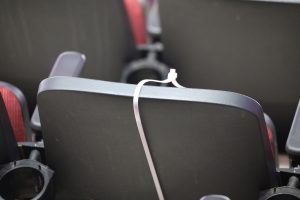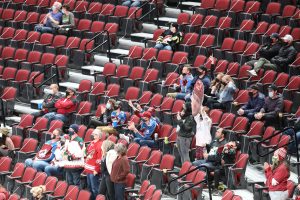- Slug: Sports-Coyotes Fans Safety, 1,904words.
- Photos available.
By Koki Riley
Cronkite News
GLENDALE – A buzz filled the air about 30 minutes before puck drop, with the Westgate Entertainment District surprisingly busy.
Maskless customers congregated around restaurant tables, laughing and chatting away. Fans lingering outside the arena – roughly half of them protecting their faces, others not – huddled around their friends and family in anticipation of the game.
It was Feb.13 and the Arizona Coyotes were about to take on the St. Louis Blues at Gila River Arena during the middle of a pandemic.
As one of three teams that started the season hosting fans, the Coyotes have served as a litmus test for the league as it monitors fan safety in an enclosed, cool-temperature environment. Although it’s both challenging and too early to measure results, some epidemiologists are skeptical about the decision to hold fans in a hockey arena in the first place.
“Hockey is especially vulnerable, we think, to super spreader events,” said Sten Vermund, Dean and Anna M.R. Lauder Professor of Public Health at Yale University.
The state of Arizona, as of Mar. 1, is 5th in the nation in COVID-19 infection rates per 100,000 residents. In January, the state had a higher infection rate than any country in the world. Although numbers are declining, some experts are worried.
Krystal Pollitt, an assistant professor at the Yale School of Public Health, said the ice pads and cool temperatures at hockey arenas introduce additional risks that go beyond the typical dangers of showing up to a public indoor event.
“There’s a difference in how the air mixes because you have a very cool temperature at the bottom, at the surface, and then that creates higher temperatures further up,” said Pollitt, who specializes in air quality related to different environmental exposures and the impact on health. “That creates a thermal inversion.”
Pollitt compares the phenomena to “what you would find in some cities where you just have this stagnant air that exists because you don’t have your typical mixing of warmer air at the bottom (and) cooler air at the top.”
In the event of a thermal inversion, infectious aerosols are then created and released by individuals who may be infected with COVID-19, she said.
While not all arenas are the same – the dimensions, size and ventilation of stadiums differ – hockey presents a unique challenge compared to other sports.
“The dynamics and airflow within an ice arena are different (from) a basketball court because you don’t have the same thermal gradients on a hardwood surface,” Pollitt said.
The Coyotes, who are now one of 10 teams in the NHL admitting fans, are allowing a maximum of 3,450, which is 25 percent capacity. The team is also following the 30-page “Guest Experience Protocol” issued by the NHL.
“We have been working diligently with the City of Glendale, state and federal authorities, medical experts, and the NHL to determine the seating capacity for our home games in January and to ensure that we have a safe environment at Gila River Arena,” a Coyotes spokesperson said. “We are confident that the innovative and tech-enabled services we have in place will protect the health and safety of our fans.”
Other changes they have made include blocking off the five rows closest to the ice. But Vermund is concerned the Coyotes and other NHL teams are not doing enough.
“The ice continuously cools the air. And when you’re skating on the ice, you’re continuously aerosolizing the ice,” Vermund said. “Cool air sinks and hot air rises. So not only do you have the air and fuel, you know (the) inversion layer, but … that cool air is not mixing with the rest of the air in the arena. It’s just sort of settling down there.”
Vermund has been working with New York City and Connecticut schools when it comes to school safety during the pandemic. He, along with his colleagues at the Yale Public School of Health, also assisted the NBA in testing players during the league’s Orlando “bubble” experiment late last summer that resulted in no positive coronavirus cases.
The potential transmission rates for the virus when placed in a hockey arena environment, Vermund believes, can be high.
This past fall, 18 members of Yale’s hockey team tested positive for COVID-19, with Vermund and his staff later learning that 95% of players on the team who were directly susceptible to potentially getting the virus got infected.
“But why haven’t we seen so many of these (super spreader) events among other sports players?” Vermund said. “We do think that maybe the actual rink experience could be contributing (to the spread).
“If I’m at a hockey game, I’d rather be sitting up in the rafters where the HVAC system is sucking the air at a very high rate.”
And beyond Yale’s hockey team, the virus has already affected the NHL season in profound ways.
Since the start of the season on Jan.13, the league has postponed 37 games due to COVID related concerns, as multiple teams have already been placed on lockdown due to COVID-19 complications.
The Coyotes have not had a COVID-19 case so far this season, despite the team having to postpone more than a couple games already due to the virus affecting their scheduled opponents in the Minnesota Wild and Colorado Avalanche.
As of now, Arizona does not have a state-wide mask mandate. And it wasn’t until June that Gov. Doug Ducey allowed counties, towns and cities to implement their own face covering regulations.
Last June in Glendale, where Gila River Arena is located, Mayor Jerry P. Weiers implemented an emergency face covering proclamation that has since stayed in place. Maricopa County, which Glendale is a part of, approved a mask-wearing regulation on that same day.
Ducey also re-opened businesses in the winter, despite prominent hospital leaders writing a letter to the Arizona Health Department asking for the state to put a hold on activities such as indoor dining, gatherings of 25 or more people and group/team sports.
“Arizona has had leaders who have been COVID-19 skeptics, and that’s part of why they have such a bad problem,” Vermund said. “Some of their leaders have not taken it nearly as seriously as they should.”
Even sports fans in Arizona have revolted against COVID-19 based restrictions during games.
At the Division III AIA high school semifinal football game between American Leadership Academy North and Snowflake, the game was paused due to a lack of mask-wearing from fans at the game. When the crowd was asked to put on their masks, fans responded by jeering and chanting “USA, USA, USA.”
No such revolt has occurred at a professional sporting event in Arizona.
The number of fans attending Coyotes games since the team’s hope opener on Jan. 14 has ranged between 1,808 and 3,237 spectators, numbers that exclude a host of other people in the arena, including players, coaches, training staff personnel, media members and arena employees.
In order to be allowed into the stadium, fans must first pass a health questionnaire through the Clear app on their phones. But even when spectators finish answering the app’s questions, the service can not certifiably confirm that the person filling out the online form is telling any kind of truth.
In contrast, the New York Rangers order fans to conduct a PCR COVID-19 test at least 72 hours before attending one of their games.
“Sports stadiums can theoretically be the source of super spreader events when an asymptomatic positive or somebody who’s symptomatic and simply lied to get into the stadium,” Vermund said.
When entering the building, fans at Gila River Arena are directed to specific entrance gates, in waves, according to their seat location. Once inside, they are required to be socially distanced. During games, fans are separated into pods, with the size of the pod depending on the number of people attending the game together. The maximum size of a pod is 10 seats, according to the NHL’s Arena Restart Protocols.
And according to Gila River Arena’s COVID-19 policies, fans are required to wear masks and be seated at least 6 feet away from other pods.
Eating and drinking are only allowed at fans’ seats during the game. Concessions and other purchases at the game are done remotely, meaning that no cash can be used for transactions.
“They had ushers going up and down the sections in between periods,” said Preston Markland, who attended a Coyotes game as a fan on Jan. 26. “And then during stoppages of play (they held) little signs that said ‘remember to wear your mask.’”
Markland noticed that there were no fans who even came close to getting inside the 6-foot limit near him during the game, and added that the use of masks was substantial.
But, as Vermund points out, having mask-wearing fans separated in the stands by at least 6 feet may not be enough to create a safe environment at games.
“The guidelines for physical distancing, 6-foot distancing … (from someone who is) potentially infectious or susceptible, are not really based on shouting or singing,” Vermund said. “So, (given) the excitement in a sports arena, people will inevitably cheer or shout, and in that sense they are projecting their droplets and aerosols far further than normal.
“Even a normal person can behave like an opera singer for a brief moment.”
Even with masks on, Vermund concludes that 12 to 18 feet of distance between people at these events is much safer, noting that he and his colleagues at the Yale School of Health have advised sports venues to maximize their social distancing policies well past 6 feet.
“If I’m angry and I shout at you, or if I’m at a sporting event and I shout, you can project particles for many feet, at least 12 feet, possibly even 18,” said Vermund, who added that “aerosols can sneak around the edges of the mask,” Vermund said.
Many of the factors that go into determining whether a sports venue is or isn’t safe enough to attend is an inexact science, said Vivian Towe, an epidemiologist and former senior analyst at the New York City Department of Health and Mental Hygiene.
“It’s all an experiment right now,” Towe said. “This is not something that a researcher can do research on.”
Towe adds that indefinable factors like COVID policy enforcement by stadium officials and the uncontrollable nature of spectators at the game only muddies the waters when it comes to specifically determining what kind of regulation of fan attendance at sporting events is necessary.
“So it’s like, what is the stadium policy? How much are they going to enforce those policies?” Towe said. “You could set those policies and not do anything about them.”
Vermund believes the NHL should revert to a bubble format – the league had been in a bubble format to finish the previous season, similar to the NBA’s bubble experiment – to keep the league’s players, coaches, fans and team staff members safe.
“Perhaps they saw Major League Baseball do it and get away with it?” Vermund said. “Perhaps they didn’t want the ongoing economic losses? I don’t know.”
His colleague, in Pollitt, when asked if it was safe enough for 2,000 fans to be seated in an ice hockey arena, was also pessimistic.
“I would view that as being quite risky,” Pollitt said.
For more stories from Cronkite News, visit cronkitenews.azpbs.org.


